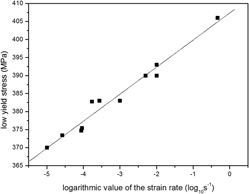Article contents
Effects of tensile elastic pre-deformation at different strain rates on the high-cycle fatigue behavior of SAE 1050 steel and fatigue life prediction
Published online by Cambridge University Press: 30 August 2016
Abstract

A series of characterization tests were performed to elucidate the high-cycle fatigue (HCF) behavior in SAE 1050 steel subjected to tensile elastic pre-deformation at different strain rates. In the pre-strained stage, the deformation was maintained constant at 0.16%, which was close to the low yield point at strain rates ranging from 10−5 s−1 to 10−2 s−1. Although pre-deformation occurred entirely in the elastic regime, using different pre-straining rates resulted in the occurrence of heterogeneous microscopic strain at different sites and locations during subsequent fatigue tests. It was found that the effect of pre-straining rate on crack initiation and crack propagation was not monotonous and was influenced by the homogeneity of deformation within grain boundaries, the integrity of the boundary structure, and the fracture toughness. In addition, the rough set theory model was introduced for the attribute reduction of characteristic parameters and provided a scientific basis to establish the fatigue model. The model was able to effectively predict the lifetime of the process of HCF in pre-strained steel. Hence, the pre-straining rate should be an important boundary condition in further studies.
- Type
- Articles
- Information
- Journal of Materials Research , Volume 31 , Issue 18: Focus Section: Reinventing Boron Chemistry for the 21st Century , 28 September 2016 , pp. 2825 - 2837
- Copyright
- Copyright © Materials Research Society 2016
References
REFERENCES
- 4
- Cited by



